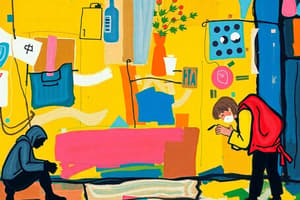Podcast
Questions and Answers
Define and differentiate between absolute and relative poverty.
Define and differentiate between absolute and relative poverty.
Absolute poverty refers to a condition where individuals live on less than $2 a day, impacting their ability to live and survive, while relative poverty is defined by community standards, affecting self-worth and identity.
Who are 'the working poor'?
Who are 'the working poor'?
- Individuals working and earning less than the poverty line (correct)
- Individuals unemployed
- Individuals in high-paying jobs
- Individuals earning above the poverty line
What factors influenced the growth of the working poor since the 1990s?
What factors influenced the growth of the working poor since the 1990s?
The gender roles switched due to the Great Recession.
Indicate how the poverty line is drawn.
Indicate how the poverty line is drawn.
How many poor people are currently in the U.S.?
How many poor people are currently in the U.S.?
How did the rate of poverty change in the U.S. since 2000?
How did the rate of poverty change in the U.S. since 2000?
What are the characteristics of short-term poverty?
What are the characteristics of short-term poverty?
What are the characteristics of long-term poverty?
What are the characteristics of long-term poverty?
What are individual explanations of poverty?
What are individual explanations of poverty?
What are structural explanations of poverty?
What are structural explanations of poverty?
Is the majority of the population in the U.S. aware of class inequalities?
Is the majority of the population in the U.S. aware of class inequalities?
How has media coverage responded to the increase in poverty since the recession?
How has media coverage responded to the increase in poverty since the recession?
How does the media depict the poor?
How does the media depict the poor?
According to the media, who is to blame for people being poor?
According to the media, who is to blame for people being poor?
What is wrong with media depictions of charitable activities?
What is wrong with media depictions of charitable activities?
What does Mantsios mean by poverty being a 'systematic' characteristic of society?
What does Mantsios mean by poverty being a 'systematic' characteristic of society?
Who are 'the wealthy' according to the media?
Who are 'the wealthy' according to the media?
How does the media depict the middle class?
How does the media depict the middle class?
What is the media's view on the relationship between 'the middle class' and the wealthy?
What is the media's view on the relationship between 'the middle class' and the wealthy?
Flashcards are hidden until you start studying
Study Notes
Definitions of Poverty
- Absolute Poverty: Living on less than $2 a day, leading to starvation and inability to survive.
- Relative Poverty: Being considered poor based on community standards, typically calculated as cost of food multiplied by three; impacts self-worth and identity.
The Working Poor
- Individuals earning less than the poverty line while being employed.
- Numbers increased during the 2000s due to gender role shifts and economic downturns.
Poverty Line and Characteristics
- Poverty Line: Determined by a low-cost food budget multiplied by three.
- Approximately 46.5 million poor Americans; 11.3 million or 7.3% unemployed.
Poverty Trends in the U.S.
- Poverty rate remained stagnant since 2000, with 15.1% of Americans living in poverty as of 2013.
Duration of Poverty
- Short-term Poverty: Lasts up to one year due to sudden life changes or events.
- Long-term Poverty: Linked to economic shifts like the Great Recession; affects job availability and stability.
Explanations of Poverty
- Individual Explanations: Faults lie with individuals, attributing poverty to lack of motivation and poor decision-making.
- Structural Explanations: Poverty is a result of systemic issues; behaviors of the poor reflect societal norms rather than individual failings.
Awareness of Class Inequalities
- Majority of the population is largely unaware of class distinctions.
- Media portrayal of wealth creates a misleading perception of American society, obscuring real poverty.
Media's Role in Poverty Awareness
- Media largely ignores the dramatic increase in poverty since the recession, with limited coverage of its implications.
- Depictions of the poor often frame them as lazy and solely responsible for their circumstances.
Blame Attribution
- Media generally attributes blame for poverty to individual shortcomings rather than systemic factors.
- Individualistic narratives dominate, overshadowing structural explanations.
Charitable Activities and Poverty
- Charitable efforts are seen as inadequate, serving as temporary solutions to deeper structural issues.
- Calls for systemic changes like increasing minimum wage rather than reliance on charity.
Systematic Nature of Poverty
- Poverty in America is viewed as an unfortunate statistic, often perceived as temporary or self-inflicted.
Media Coverage of Wealthy
- A significant portion of media is devoted to wealthy individuals and their concerns, such as stocks and foreign policy.
- The issues of the wealthy are framed as universally relevant.
Personal Characteristics of Different Classes
- The media creates stereotypes, positioning the poor as "them" and the middle/wealthy as "us" to suggest moral superiority.
Relationship Between Classes
- Media blurs distinctions between the middle class and the wealthy, presenting them as a homogenous group.
- Wealthy individuals are depicted as ruling the society, holding disproportionate influence over income and political spheres.
- Class tensions are inverted, causing blame to fall on the poor rather than the wealthy, who control the economic narrative.
Studying That Suits You
Use AI to generate personalized quizzes and flashcards to suit your learning preferences.




